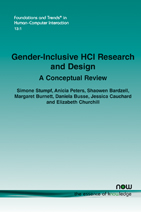Gender-Inclusive HCI Research and Design: A Conceptual Review
By Simone Stumpf, City, University of London, UK, Simone.Stumpf.1@city.ac.uk | Anicia Peters, Namibia University of Science and Technology, Namibia, apeters@nust.na | Shaowen Bardzell, Indiana University, USA, selu@indiana.edu | Margaret Burnett, Oregon State University, USA, burnett@eecs.oregonstate.edu | Daniela Busse, Oracle, USA, danielabusse@fastmail.us | Jessica Cauchard, Ben Gurion University of the Negev, Israel, jcauchard@acm.org | Elizabeth Churchill, Google, USA, churchill@acm.org
Abstract
Previous research has investigated gender and its implications for HCI. We consider inclusive design of technology whatever the gender of its users of particular importance. This conceptual review provides an overview of the motivations that have driven research in gender and inclusive HCI design. We review the empirical evidence for the impact of gender in thinking and behavior which underlies HCI research and design. We then present how HCI design might inadvertently embed and perpetuate gender stereotypes. We then present current HCI design approaches to tackle gender stereotypes and to produce gender-inclusive designs. We conclude by discussing possible future directions in this area.
Gender-Inclusive HCI Research and Design: A Conceptual Review
Recent years have seen a growing number of calls for considering gender in the design or evaluation of software, websites, or other digital technology. Calls like these have arisen from an emerging awareness in HCI of findings from the social sciences that are relevant to the way people use and design technology. However, emerging work on bringing together gender research with software design choices is fragmented across multiple disciplines. This monograph aims to help bring such works together, by synthesizing the current state of affairs and future possibilities on how gender comes together with HCI design.
The authors of this monograph consider inclusive design of technology whatever the gender of its users of particular importance. This conceptual review provides an overview of the motivations that have driven research in gender and inclusive HCI design. The authors review the empirical evidence for the impact of gender in thinking and behavior which underlies HCI research and design. They present how HCI design might inadvertently embed and perpetuate gender stereotypes. They also present current HCI design approaches to tackle gender stereotypes and produce gender-inclusive designs. The monograph concludes by discussing possible future directions in this area.
